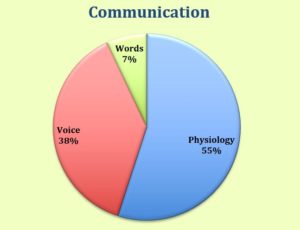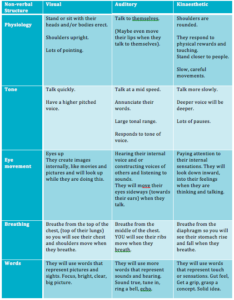

What is Non-Verbal Communication?
Table of Contents
Most of what we communicate to others happens without us really thinking about it. This is known as non-verbal communication.
If you think you know what you are saying and how you appear to people, you might want to think again.
We might be alert and aware of the words we choose but are we as cautious in the way we stand or the hand gestures we make?
Non-Verbal Communication Percentage
According to a detailed study on non-verbal communication by Psychology Professor Albert Mehrabian, what makes up communication isn’t what you might expect.
Interestingly he found that only a small percentage of communication is based on words (7%). The majority of our communication comes from our body language, (our physiology) at 55 percent and the way we hear the message as 38 percent.
Non-Verbal Communication Examples
That means that the way we stand, the gestures we make, and how we hold our head is important to our communication, especially if we want people to like us.
The other factor is how someone hears the words, so how loud or soft we speak, how fast or slow, how high or low and the quality of our voice also has a significant impact in our communication and whether people like who we are and what we are saying.
For example, if you say the word “yes” and shake your head, (no), the shaking of your head will override your words. The person will perceive you saying No. If you say you have a very exciting day, using a slow, low bored tone, the person listening will not believe you.
In most cases, we automatically match what we are saying to our tone and our body language.
When we are excited, we show more energy, we move a lot more, talk rapidly, have a high pitch and increased volume, our breathing is fast and high. You do not need to understand the words someone says to know that a person is excited.
Someone scared will move in a similar way to excited but you can easily tell from their facial expressions that they are not enjoying it. The pitch of their voice is higher. Their mouth will be tighter and stretched out and down, their eyes bigger with more white showing, even their skin colour will be different to a person who is excited.
When we are sad, everything about our communication usually reads sad. Our voice is low and slow and loses quality, becoming gravelly, raspy or choked. Our body is slouched and rounded. We move less and movements are slow.
The Importance of Non-Verbal Communication
Sometimes though, what we say and how we move or speak doesn’t match up. If you say to someone, “I am listening,” but you are continuing with a task or don’t make eye contact, they will probably feel that you are not listening. If you say, “I’m happy for you,” when you are tired or feeling unwell, the person listening will hear that you are not happy for them.
Mismatches in communication are not necessarily intentional, if we are sick with a cold, distracted or stressed we may not convey what we want to say, even though we meant the words truthfully.
Other times it might be more intentional, but still unconscious. If we say yes when we really want to say no, if we don’t agree with what a person is saying but want to appear polite, then our body language might reveal we are conflicted or uncertain. When we know a person very well we might be able to tell when they are mismatching what they say and how they look or sound quite easily, even something small, like a twitch or an eye movement might give away a mismatch and show an internal conflict.
We can also turn our attention to our own body language to reinforce the meaning of the words we use, as well as increasing our approachability and likability. By nodding when we say yes we are confirming and amplifying our message.
In a study completed at Hokkaido University, researchers had participants watch videos of female faces that were computer-generated. Some of the animations nodded their heads, others shook their heads and others were still.
Participants were asked to rank which faces they liked and felt they would be able to approach. The nodding faces won hands down.
Non-Verbal Communication Examples
Actions like standing with arms and hands open is a posture of listening and openness. You can help to build trust and empathy if you show that you are open to what the other person is saying. The simple act of looking someone in the eye and smiling can increase focus and show commitment. The act of smiling when you are talking to someone on the phone will resonate in your voice and increase the warmth and tone of your words.
Matching another person’s body language and voice is another way to improve trust and likeability. It shows that you are listening and agree with them. You do not need to match them exactly – it’s probably best if you don’t, but even subtle matches or opposite matches (like a mirror) will build rapport and unconscious trust. As well as speaking at the same volume, the same speed and the same pitch. Again, you don’t have to be exactly alike, if you speak with a high voice and they speak low, bringing your voice pitch down a little will make a difference.
It’s important to note that it’s very difficult to accurately read a person’s body language. A person who crosses their legs during a conversation might disagree, agree or need to go to the bathroom. There is no way to know what the reason is without asking them.
Someone might cross their arms for any number of reasons. These reasons might be internal, dealing with their own conflict or thoughts, it might be external, to do with the atmosphere in the room. They could be responding to the person who is speaking or they could be reacting to another listener’s reaction and body language.
It might not be what you are saying that they disagree with but how long it’s taking to say it.
Someone sitting with their arms crossed might simply be doing it because they agree with or like the person on the opposite side of the table who has crossed arms.
The only real way to know what a person is thinking or feeling is to study all pathways of communication thoroughly and master them, or, you can simply ask them. If you notice something that seems like a mismatch in body language and words, or words and tone, take the time to ask that person if there is something they would like to say or add, or if they are okay with what you just said.
Remember that we are not always aware of our body language, they might not be intentionally drawing attention to themselves.
You can also change body language deliberately to get into a new mood. If you need to study but don’t feel like it you can alter your mood by sitting up straight, becoming aware of your peripheral vision and increasing the speed of your internal dialogue.
NLP and Non-Verbal Communication
If you have studied Neuro-Linguistic Programming (NLP) you will already have the ability to recognise sensory acuity and calibrate on these. You can take it one step further by matching non-verbal communication with internal representation systems.
If you have completed Excellence Now then you are already familiar with the three main Internal Representation Systems; Visual, Auditory and Kinaesthetic (VAK). With NLP you can couple these up to determine a person’s non-verbal structure.
Here’s a break down to show you how it works:
Having a deeper knowledge of non-verbal communication gives us the ability to say the things we really want to say in the way we actually mean to say them. It also gives us the ability to tune into other people and help them feel safe and comfortable with us.
Kindest regards,
Matt Catling








